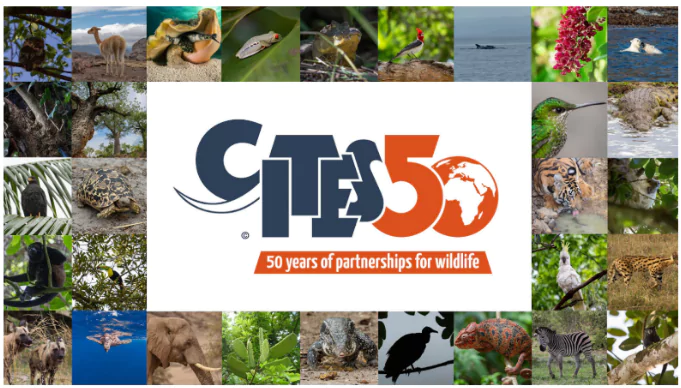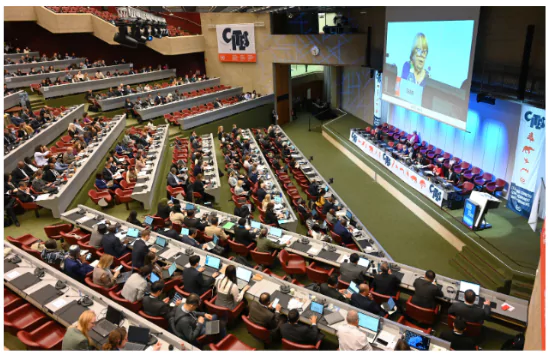Get the CITES Full Form, establishment year (1973), HQ location (Geneva), and learn how CITES has regulated global wildlife trade for over 50 years. Explore its history, impact, and role in biodiversity conservation.

CITES Full Form stands for Convention on International Trade in Endangered Species of Wild Fauna and Flora. This internationally recognised agreement plays an important role in conserving biodiversity by regulating international trade in specimens of wild animals and plants. Interested candidates must read in depth what is CITES, when was CITES established, the CITES headquarters, CITES Appendices, and the remarkable impact of this treaty over the last 50 years.
Marking 50 years of CITES in 2023 was a testament to the global commitment toward protecting biodiversity. Over the decades, CITES has played a crucial role in curbing illegal trade, rehabilitating endangered species, and supporting sustainable livelihoods through wildlife use.

Key programs such as the Monitoring the Illegal Killing of Elephants (MIKE) have led to a reduction in elephant poaching across Africa and Asia. The development of tools like the CITES Trade Database has also made it easier for member states to track legal trade and identify trends.
Wildlife Conservation In India: Initiatives, Achievements & …
The Convention on International Trade in Endangered Species of Wild Fauna and Flora (commonly known by its acronym CITES) is an international agreement between governments. Its main goal is to ensure that international trade in specimens of wild animals and plants does not threaten their survival. The CITES Full Form is Convention on International Trade in Endangered Species of Wild Fauna and Flora, which refers to the globally respected treaty designed to regulate and monitor wildlife trade for sustainability.
| CITES Overview | |
| Aspect | Details |
| CITES Full Form | Convention on International Trade in Endangered Species of Wild Fauna and Flora |
| What is CITES? | An international agreement to ensure that global trade in wild animals and plants is sustainable |
| CITES Founded Year | 1973 |
| CITES Established In | Entered into force on 1 July 1975 |
| When was CITES Established? | Signed on 3 March 1973 in Washington, D.C., USA |
| Parties to the Convention | 185 (as of the latest update) |
| CITES Headquarters | Geneva, Switzerland |
| Administered By | United Nations Environment Programme (UNEP) |
| Appendices of CITES | Three Appendices:
• Appendix I – Species threatened with extinction • Appendix II – Species not necessarily threatened but trade controlled • Appendix III – Species protected in at least one country requesting CITES support |
| Number of Protected Species | Over 40,900 (approx. 6,610 animals and 34,310 plants) |
| CITES Decision-Making Body | Conference of the Parties (CoP) |
| CITES Permit System | Regulates import, export, re-export, and introduction from the sea through a licensing system |
| Funding Mechanism | Core: CITES Trust Fund (CTL)
External: CITES External Trust Fund (QTL) |
| Significance of CITES | Ensures that international wildlife trade is legal, sustainable, and traceable |
| 50 Years of CITES | Celebrated in 2023, marking half a century of global conservation efforts |
CITES Full Form stands for the Convention on International Trade in Endangered Species of Wild Fauna and Flora. It is an international agreement between governments aimed at ensuring that global trade in wildlife does not threaten species survival. Established in 1973, CITES plays a crucial role in protecting endangered plants and animals.
CITES was established in 1973 after being drafted at a meeting in Washington, D.C., by representatives from 80 countries. It came into force on July 1, 1975. Hence, CITES founded year is considered 1973, with operational activities beginning two years later. This makes 2023 the celebration of 50 years of CITES, marking a significant milestone in international environmental cooperation.
Back in the 1960s, international concern over the unsustainable exploitation of wildlife for trade purposes was just beginning to emerge. There was no coordinated framework to regulate this booming trade. Species such as tigers, elephants, rhinos, and many plant varieties were being heavily exploited, often to the brink of extinction.
The international wildlife trade today is worth billions of dollars annually, involving hundreds of millions of specimens, ranging from live animals and plants to products like leather, wood, and traditional medicines. Given the cross-border nature of such trade, international cooperation became essential. Hence, CITES was conceived as a binding agreement among nations to regulate and monitor this trade effectively.
The CITES Secretariat is based in Geneva, Switzerland, and is administered by the United Nations Environment Programme (UNEP). It provides support to its 185 member countries—referred to as Parties—and manages the international permit system that facilitates legal and sustainable trade in wildlife.
The Secretariat provides support to the treaty’s Parties and oversees the implementation of its provisions. This makes CITES headquarters not only a hub for operational management but also a center of global conservation dialogue.

Source: CITES
Currently, 185 countries are Parties to CITES. These Parties voluntarily agree to be bound by the Convention and are responsible for enacting national laws to implement its provisions. While CITES is legally binding, it does not override domestic legislation. Instead, it provides a framework within which each country must operate.
The Conference of the Parties (CoP) is the supreme decision-making body under CITES. It meets every 2–3 years to assess the treaty’s effectiveness, update species listings, and enhance regulatory mechanisms.
CITES operates through a well-defined licensing system. Trade in species listed by the convention is regulated via permits and certificates issued by designated national authorities:
The implementation of the CITES Full Form is not limited to legal texts. It is brought to life through national legislation in each Party country, tailored to implement CITES standards domestically.
One of the most important operational mechanisms of the Convention is the classification of species into three Appendices, each reflecting a different level of protection:
Understanding the appendices of CITES is fundamental to learn how species are prioritised and protected under the convention. On the other hand, it helps to implement tailored regulatory controls on international trade.
Over its 50-year history, CITES has played a crucial role in protecting over 40,900 species, including roughly 6,610 animal species and 34,310 plant species. It has been instrumental in reducing the illegal killing of elephants through initiatives like the MIKE Programme (Monitoring the Illegal Killing of Elephants) and in bringing species such as crocodiles and certain big cats back from the brink.
Nonetheless, challenges remain. Illegal wildlife trade continues to flourish, driven by demand for exotic pets, traditional medicines, and fashion products. CITES faces the uphill task of keeping pace with increasingly sophisticated trafficking networks, while also ensuring that its regulations support rather than hinder the livelihoods of rural communities dependent on wildlife resources.
CITES has been acknowledged in key international policy frameworks such as Rio+20 and the UN’s 2030 Agenda for Sustainable Development. The Convention plays a critical role in achieving SDG targets related to biodiversity conservation, sustainable resource use, and poverty eradication. In this sense, CITES bridges the gap between trade, environment, and development.
Though the convention is legally binding, it does not replace national laws. Instead, it serves as a framework for each country to develop its own legislation. Countries must establish national management and enforcement systems to ensure compliance with CITES.
CITES is financed through:
Contributions come from Parties and other organisations dedicated to wildlife conservation.
In the face of challenges like climate change, habitat loss, and illegal wildlife trade, CITES remains a dynamic and evolving agreement. The focus for the future includes:
The CITES Full Form, thus, represents more than just an acronym; it symbolises a global movement dedicated to conserving biodiversity through international cooperation.
The CITES Full Form, officially CITES – Convention on International Trade in Endangered Species of Wild Fauna and Flora, signifies a pioneering global effort to ensure that international trade does not threaten wildlife. Since its inception in 1973, CITES has grown into one of the most impactful environmental agreements, providing a solid framework for international cooperation and sustainable development.
As we look beyond 50 years of CITES, its mission remains as urgent as ever. With growing threats to biodiversity, CITES continues to serve as a living promise—not only to nature but to future generations. The strength of this Convention lies in the collective responsibility of its Parties, the engagement of local communities, and the global commitment to preserve life on Earth through sustainable trade.
Ready to boost your UPSC 2025 preparation? Join PW’s UPSC online courses today!
CITES is an international treaty that regulates trade in endangered species of wild fauna and flora to ensure their survival in the wild.
CITES was established in 1973 and entered into force on July 1, 1975, marking a major step in international wildlife conservation efforts.
It is a global agreement, also known as CITES, that ensures international wildlife trade does not threaten species with extinction.
The CITES Secretariat is headquartered in Geneva, Switzerland, under the administration of the United Nations Environment Programme (UNEP).
The CITES Appendices (I, II, and III) classify species based on their risk levels and regulate trade through specific permit requirements.
The 50th anniversary of CITES in 2023 highlights five decades of international cooperation to protect over 40,000 species from unsustainable trade.

<div class="new-fform">
</div>